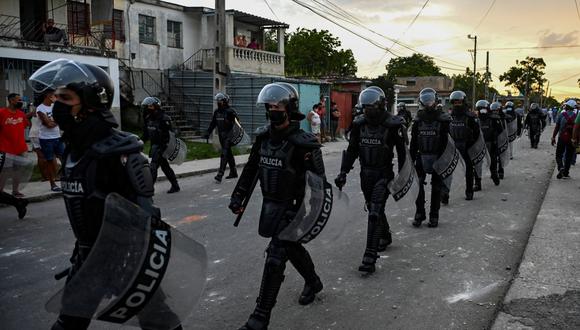RIO DE JANEIRO, BRAZIL – A week after the largest wave of citizen protests in more than six decades, the police and military are exhaustively guarding the streets of Cuba, especially in the city of San Antonio de los Baños, where it all began.
The accesses to this town 30 kilometers west of Havana and famous for its International Film School were mostly cut off or guarded by security agents on Sunday.
Read also: Check out our coverage on Cuba
Although the streets showed a normal flow of people, trucks full of soldiers could be seen, and the city’s central square was occupied by more than a dozen police, military, and agents of the Ministry of State Security, Cuba’s intelligence and counterintelligence agency, dubbed by opponents the “Cuban political police.”
NOMADS AND TRAVELERS
Uniformed and non-uniformed agents were also widely deployed in the neighboring town of Bauta, where “there was a policeman on every corner,” a woman who was there Sunday morning told Efe agency.

Internet access was cut off in San Antonio de los Baños and its surroundings, while in the rest of the island, it is mostly restricted, although it occasionally works on some cell phones.
Neither the government nor the Cuban telecommunications monopoly (Etecsa) explained why mobile data had been partially or totally down since Sunday, July 11, when thousands of Cubans took to the streets to protest, clashes, altercations, and even looting took place in some localities. Neither have they informed when the service will be restored and will operate normally.
The tranquility in San Antonio de los Baños this Sunday contrasts with the turmoil experienced the previous Sunday when thousands of residents took to the streets to protest peacefully.
The demonstrators launched slogans against the government, whom they blame for the shortage of food, basic products, and medicines, the proliferation of stores paying only in foreign currency, and the usual power cuts, at a time when Cuba is going through a serious economic crisis, with its coffers empty and unable to meet its debts, in addition to a dangerous rise in cases of Covid-19 in recent weeks.
The live videos recorded by the demonstrators in San Antonio de los Baños lit the fuse of dozens of protests by disgruntled citizens in other localities of the island, which were harshly dealt with by the security forces, leaving hundreds of people injured and detained and generating strong criticism from the international community to the government headed by Miguel-Díaz-Canel.
In fact, the president went to San Antonio de los Baños on the day of the protests together with security forces and a group of acolytes to send the message that “the street belongs to the revolutionaries”, about the supporters of the one-party system and centralized economy that has prevailed in Cuba since 1959.
Another argument constantly repeated by Cuban authorities since 9/11 is that the “blockade” is to blame for Cuba’s economic ruin. The protests have supposedly been instigated by the U.S. Administration through a sophisticated system of manipulation of opinions through social networks.
With restricted internet and heavy police presence, one of the few notable events in Cuba this Sunday was a rally of government supporters in La Güinera, a lower-class neighborhood in southern Havana where riots took place last Monday, resulting in the only officially reported death.
Led by Gerardo Hernández, president of the Committees for the Defense of the Revolution (CDR, the “eyes and ears” of the State in the neighborhoods), Cuban authorities accompanied dozens of partisan neighbors “in support of the Revolution, Díaz-Canel and the Party”, as tweeted by the former spy and member of the famous Cuban “five heroes”.
On Saturday, the Cuban government showed its muscle with a mass rally attended by thousands of people (100,000 according to authorities) in Havana to show their support for the government and the leader, backed by his predecessor Raul Castro.
Source: efe

